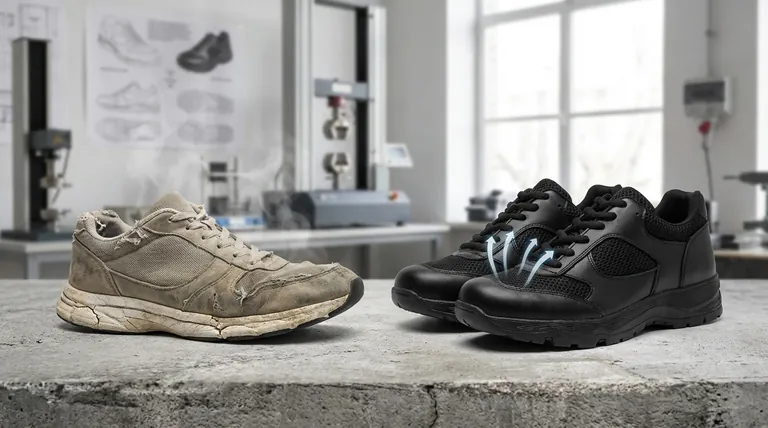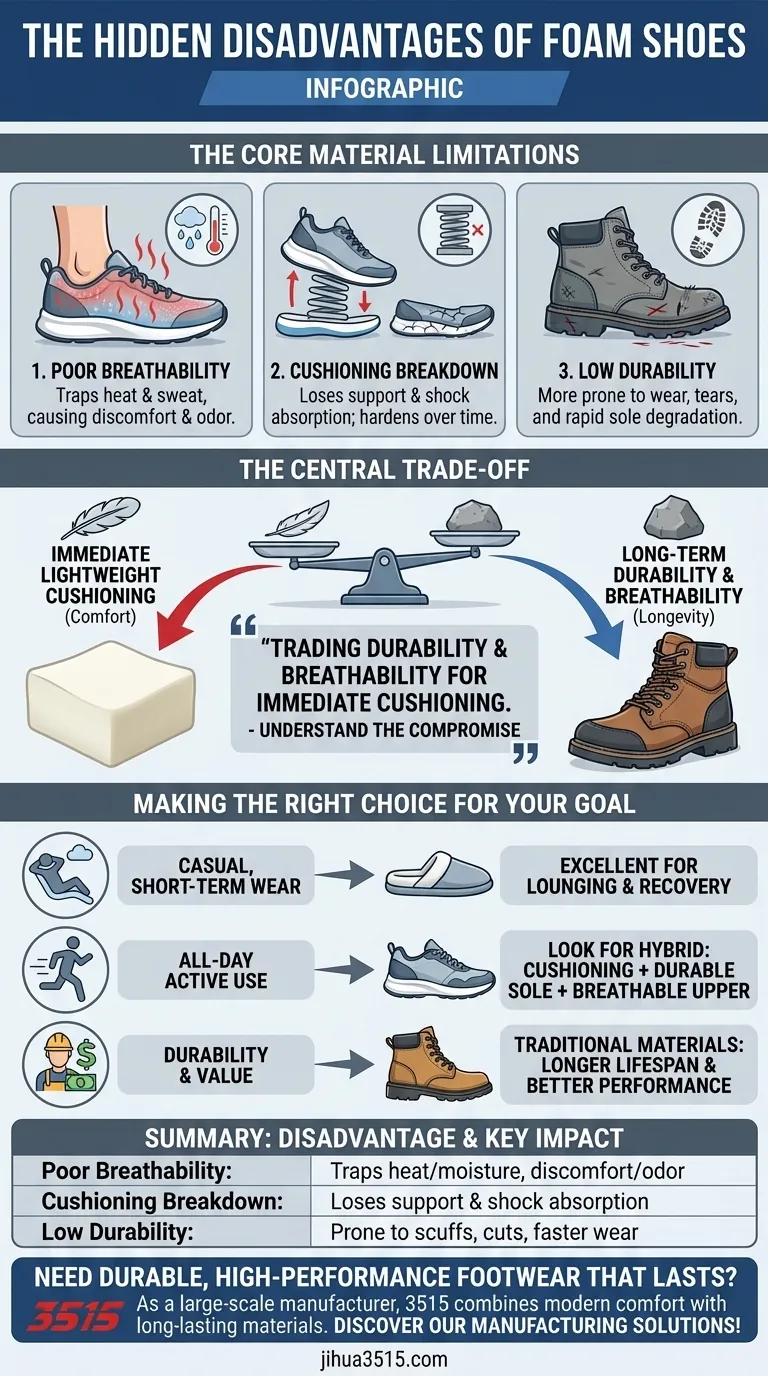While praised for their initial comfort, foam shoes have three significant disadvantages. Their material composition leads to poor breathability which traps heat and sweat, they are less durable than shoes made from traditional materials, and their signature cushioning degrades over time, hardening and losing its supportive quality.
The central trade-off with foam footwear is clear: you are exchanging long-term durability and breathability for immediate, lightweight cushioning. Understanding this compromise is key to deciding if they are right for your needs.

The Core Material Limitations of Foam
The very properties that make foam feel soft and lightweight are also the source of its primary drawbacks. These issues are not design flaws but inherent characteristics of the material itself.
Heat and Moisture Retention
Foam, by its nature, is not a highly breathable material. Its structure traps air and, consequently, heat from your foot.
This lack of ventilation prevents sweat from evaporating effectively. The result is a warm, damp environment inside the shoe that can lead to discomfort and create an ideal breeding ground for odor-causing bacteria.
The Breakdown of Cushioning
The "bouncy" and supportive feel of new foam shoes comes from the material's ability to compress under pressure and then rebound.
However, with repeated impact from walking and standing, the foam's cellular structure begins to break down. This process, often called "packing out," causes the material to harden and lose its shock-absorbing properties.
Susceptibility to Wear and Tear
Compared to materials like dense rubber or leather, foam is significantly less durable. It is more prone to scuffs, cuts, and abrasions from everyday use.
This is especially true for shoes where the outsole is also made of foam. These soles wear down much faster than traditional rubber outsoles, leading to a shorter overall lifespan for the footwear.
Understanding the Trade-offs
Choosing foam footwear is a matter of prioritizing certain benefits while accepting the corresponding compromises. Being aware of these trade-offs is crucial for avoiding disappointment.
Comfort vs. Breathability
The soft, conforming nature of foam provides excellent initial comfort and can help support arches and reduce foot pain.
This benefit comes at the direct cost of air circulation. While foam can provide warmth in sedentary situations, it is often a poor choice for highly active use or warm climates where heat and sweat management are critical.
Lightweight Feel vs. Long-Term Durability
One of the most appealing features of foam shoes is how lightweight they are, reducing fatigue over short periods.
This is a direct result of the material's low density, which also makes it less resistant to physical wear. A heavier shoe with a robust rubber sole will almost always outlast an all-foam counterpart.
Making the Right Choice for Your Goal
By aligning your footwear choice with its intended use, you can leverage the benefits of foam while minimizing its drawbacks.
- If your primary focus is casual, short-term wear: Foam shoes are an excellent choice for lounging, running errands, or as post-activity recovery footwear.
- If your primary focus is all-day active use: Look for hybrid shoes that use foam in the midsole for cushioning but feature a durable rubber outsole and a breathable upper material.
- If your primary focus is durability and value: A shoe made from more traditional materials will likely offer a longer lifespan and better performance over time, justifying a higher initial cost.
Ultimately, understanding these material limitations allows you to select footwear that truly aligns with your needs for comfort, activity, and longevity.
Summary Table:
| Disadvantage | Key Impact |
|---|---|
| Poor Breathability | Traps heat and moisture, leading to discomfort and odor. |
| Cushioning Breakdown | Loses support and shock absorption over time. |
| Low Durability | More prone to scuffs, cuts, and faster sole wear. |
Need durable, high-performance footwear that lasts?
As a large-scale manufacturer, 3515 produces a comprehensive range of durable shoes and boots for distributors, brand owners, and bulk clients. We combine modern comfort with long-lasting materials to overcome the limitations of foam footwear.
Contact us today to discuss your footwear needs and discover our manufacturing solutions!
Visual Guide

Related Products
- Wholesale Durable & Breathable Training Shoes for Custom Brands
- Premium KPU Athletic Safety Shoes for Wholesale
- Custom OEM Training Shoes Wholesale Manufacturer Durable & Breathable
- Safety Footwear Wholesale Manufacturer for Custom OEM/ODM Production
- Wholesale Training Shoes with Dial Lacing System Custom OEM Manufacturing
People Also Ask
- What factors should be considered when choosing footwear for different activities? Maximize Performance & Safety
- What is the primary role of shoes in physical activities? Protection, Support & Performance
- What is high-tech 'air' mesh, and how is it used in footwear? The Key to Cool, Lightweight Shoes
- What was discovered about three-quarter cut aerobic shoes in the 90s? The Dangerous Illusion of Ankle Support
- What is a Flyknit shoe? The Ultimate Guide to Seamless, Lightweight Performance



















